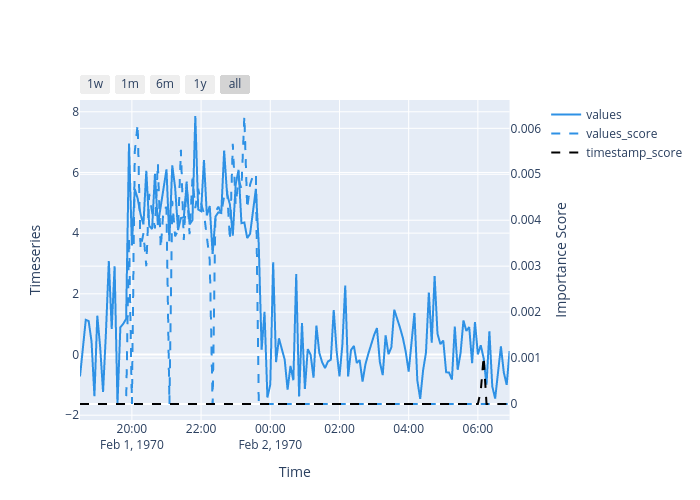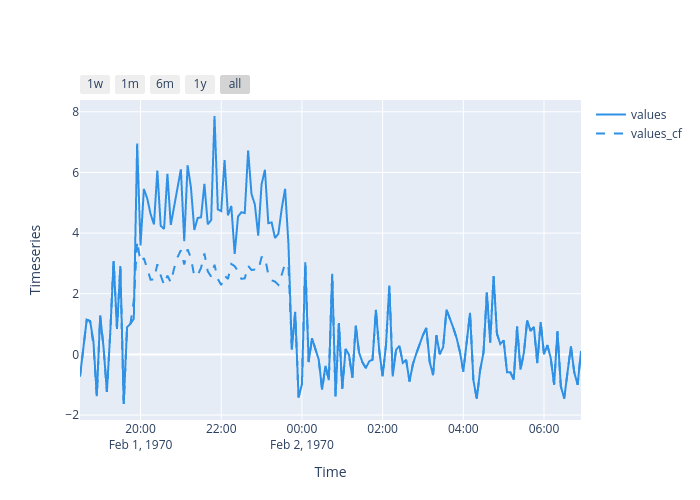TimeseriesExplainer for time series anomaly detection
The class TimeseriesExplainer is designed for time series data, acting as a factory of the supported tabular explainers such as SHAP and MACE. TimeseriesExplainer provides a unified easy-to-use interface for all the supported explainers. In practice, we recommend applying TimeseriesExplainer to generate explanations instead of using a specific explainer in the package omnixai.explainers.timeseries.
[1]:
# This default renderer is used for sphinx docs only. Please delete this cell in IPython.
import plotly.io as pio
pio.renderers.default = "png"
[2]:
import os
import numpy as np
import pandas as pd
from omnixai.data.timeseries import Timeseries
from omnixai.explainers.timeseries import TimeseriesExplainer
The time series data used here is a sythentic univariate time series dataset. We recommend using Timeseries to represent a time series dataset. Timeseries contains one univariate/multivariate time series, which can be constructed from a pandas dataframe (the index in the dataframe represents the timestamps and the columns are the variables).
[3]:
# Load the time series dataset
df = pd.read_csv(os.path.join("./data", "timeseries.csv"))
df["timestamp"] = pd.to_datetime(df["timestamp"], unit='s')
df = df.rename(columns={"horizontal": "values"})
df = df.set_index("timestamp")
df = df.drop(columns=["anomaly"])
print(df)
values
timestamp
1970-01-01 00:00:00 1.928031
1970-01-01 00:05:00 -1.156620
1970-01-01 00:10:00 -0.390650
1970-01-01 00:15:00 0.400804
1970-01-01 00:20:00 -0.874490
... ...
1970-02-04 16:55:00 0.362724
1970-02-04 17:00:00 2.657373
1970-02-04 17:05:00 1.472341
1970-02-04 17:10:00 1.033154
1970-02-04 17:15:00 2.950466
[10000 rows x 1 columns]
[4]:
# Split the dataset into training and test splits
train_df = df.iloc[:9150]
test_df = df.iloc[9150:9300]
# A simple threshold for detecting anomaly data points
threshold = np.percentile(train_df["values"].values, 90)
The outputs of the detector are anomaly scores instead of anomaly labels (0 or 1). A test instance is more anomalous if it has a higher anomaly score.
[5]:
# A simple detector for determining whether a window of time series is anomalous
def detector(ts: Timeseries):
anomaly_scores = np.sum((ts.values > threshold).astype(int))
return anomaly_scores / ts.shape[0]
To initialize TimeseriesExplainer, we need to set the following parameters:
explainers: The names of the explainers to apply, e.g., [“shap”, “mace”].data: The data used to initialize explainers.datais the training dataset for training the machine learning model.model: The ML model to explain, e.g., a black-box anomaly detector.preprocess: The preprocessing function converting the raw data (aTimeseriesinstance) into the inputs ofmodel.postprocess(optional): The postprocessing function transforming the outputs ofmodelto a user-specific form, e.g., the anomaly labels.mode: The task type, e.g., “anomaly_detection” or “forecasting”.params: Additional parameters for each explainer, e.g., MACE requires a threshold to determine anomaly labels.
[6]:
# Initialize a TimeseriesExplainer
explainers = TimeseriesExplainer(
explainers=["shap", "mace"],
mode="anomaly_detection",
data=Timeseries.from_pd(train_df),
model=detector,
preprocess=None,
postprocess=None,
params={"mace": {"threshold": 0.001}}
)
# Generate explanations
test_instances = Timeseries.from_pd(test_df)
local_explanations = explainers.explain(
test_instances,
params={"shap": {"nsamples": 1000}}
)
|███████████████████████████████████████-| 98.0%
ipython_plot plots the generated explanations in IPython. Parameter index indicates which instance to plot, e.g., index = 0 means plotting the first instance in test_instances.
[7]:
index=0
print("SHAP results:")
local_explanations["shap"].ipython_plot(index)
print("MACE results:")
local_explanations["mace"].ipython_plot(index)
SHAP results:

MACE results:

The dash lines show the importance scores and the counterfactual example, respectively. SHAP shows the most important timestamps make this test instance detected as an anomaly. MACE provides a counterfactual example showing that it will not be detected as an anomaly if the metric values from 20:00 to 00:00 are around 2.0.
Given the generated explanations, we can launch a dashboard (a Dash app) for visualization by setting the test instance and the generated local explanations.
[8]:
from omnixai.visualization.dashboard import Dashboard
dashboard = Dashboard(instances=test_instances, local_explanations=local_explanations)
dashboard.show()
Dash is running on http://127.0.0.1:8050/
* Serving Flask app "omnixai.visualization.dashboard" (lazy loading)
* Environment: production
WARNING: This is a development server. Do not use it in a production deployment.
Use a production WSGI server instead.
* Debug mode: off
* Running on http://127.0.0.1:8050/ (Press CTRL+C to quit)